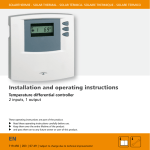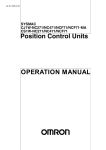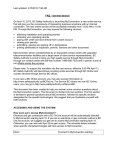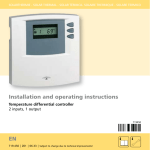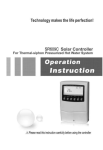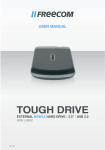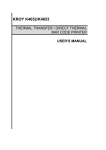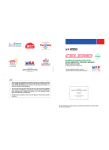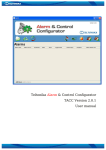Download Operating instructions US
Transcript
SOLARTHERMIE - SOLAR THERMAL - SOLAR TÉRMICO - SOLAIRE THERMIQUE Operatinginstructions Temperature Differential Controller inputs, 1 output These operating instructions are part of the product. Read these operating instructions carefully before use. Keep them over the entire lifetime of the product and pass them on to any future owner or user of this product. US 717.025 | Z02| 06.26 | Subject to change due to technical improvements! US Quickguideforendusers Safety WARNING Risk of death by electrocution! Do not open the controller case. Only clean the controller case using a dry cloth. Installation, commissioning, maintenance and dismantling of the temperature difference controller may only be performed by trained professional personnel. Display Operating buttons The operational tasks of the end user are limited to reading the temperature values and detecting faults. All other operational tasks may only be performed by trained professional personnel. Readingtemperaturevalues The temperature sensors measure the temperatures on the collector (T1), in the lower section of the storage tank (T2) and – if connected - in the upper section of the storage tank (T). The temperatures are shown on the display. Select temperature sensor (T1, T2, T) using the and operating buttons. The selected temperature sensor and the current measured temperature are shown on the display. Detectingfaults 2 Check the display regularly. In case of faults, isolate the cause (see Chapter 9). 717.025 | 06.26 Temperature (example) Temperature sensor °F T1 T1 ! T3 max T2 max °C °F T1 D US As soon as it becomes evident that safe operation is no longer possible (e.g. visible damage), remove the device from the mains supply immediately. Have a trained technician remedy the fault. Content Quick guide for end users.......................2 Safety.........................................................2 Reading temperature values.......................2 Detecting faults..........................................2 1 About this manual............................4 1.1 Applicability.........................................4 1.2 Users....................................................4 1.3 Description of symbols........................4 2 Safety................................................6 2.1 Proper usage.......................................6 2.2 Improper usage...................................6 2.3 Dangers during assembly and commissioning....................................6 2.4 Exclusion of liability.............................7 3 Description........................................9 3.1 Controller in the solar circuit...............9 3.2 Case overview....................................10 4 Installation......................................11 4.1 Overview of the device versions.........11 4.2 Opening/closing the housing.............12 4.3 Assembly...........................................13 4.4 Electrical connection..........................14 717.025 | 06.26 5 Display overview.............................17 6 Commissioning ..............................18 7 Description of the controller functions.........................................19 7.1 Automatic storage tank charging......19 7.2 Automatic charging shutdown..........19 7.3 Automatic pump blockage................20 7.4 Tube collector function......................20 7.5 Holiday function................................21 7.6 Anti-freeze function...........................21 8 Operation........................................22 8.1 Reading temperature values..............22 8.2 Setting the controller.........................22 9 Faults...............................................25 9.1 Fault causes.......................................25 9.2 Testing the temperature sensors........28 10 Dismantling and disposal...............30 11 Manufacturer’s warranty . .............30 12 Specifications..................................32 US 1 About this manual 1.1 Applicability This manual describes the installation, commissioning, function, operation, maintenance and dismantling of the temperature difference controller for solar thermal energy systems. When installing the remaining components, e.g. the solar collectors, the pump assemblies and the storage unit, be sure to observe the appropriate installation instructions provided by each manufacturer. 1.2 Users Installation, commissioning, operation, maintenance and dismantling of the controller may only be performed by trained professional personnel. The professional personnel must be familiar with this operation manual and follow the instructions contained herein. The end user may only perform operating functions, which are explained in the quick guide. 1.3 Description of symbols 1.3.1 The structure of the warning notices SIGNAL WORD Type, source and consequences of the danger! Measures for avoiding danger. 717.025 | 06.26 Pictogram US 1.3.2 Danger levels in warning notices Danger level DANGER WARNING CAUTION CAUTION Probability of occurrence Imminent threat of danger Possible threat of danger Possible threat of danger Possible threat of danger Consequences resulting from non-compliance Death, serious bodily injury Death, serious bodily injury Minor bodily injury Property damage 1.3.3 Notes Note Notes on easier and safer working habits. Measures for easier and safer working habits. 1.3.4 Other symbols and markings Symbol ✓ • Emphasis on issue at hand 717.025 | 06.26 Meaning Condition for action Call to action Result of action List Emphasis on issue at hand US 2 Safety 2.1 Proper usage The temperature difference controller (below called controller) may only be used for controlling solar thermal systems within the permissible ambient conditions (see Chapter 12). 2.2 Improper usage The controller must not be operated in the following environments: • Outdoors • In moist rooms • In rooms where highly flammable gas mixtures can occur 2.3 Dangers during assembly and commissioning The following dangers exist during assembly / commissioning of the controller and during operation (in case of assembly errors): • Risk of death by electrocution • Risk of fire due to short-circuit • Damage to any of the constructional fire safety measures present in the building due to incorrectly installed cables • Damage to the controller and connected devices due to improper ambient conditions, inappropriate power supply and connecting prohibited devices Therefore, all safety regulations apply when working on the mains supply. Only electricians may perform work that requires opening the controller (such as connecting or replacing the fuse). When laying cables, ensure that no damage occurs to any 717.025 | 06.26 US of the constructional fire safety measures present in the building. Make sure that the permissible ambient conditions at the installation site – in particular, the specified protection class – are not exceeded (see Chapter 12). Factory labels and markings may not be altered, removed or rendered unreadable. Before connecting the device, make sure that the power supply matches the specifications on the type plate. Make sure that all devices which are connected to the controller conform to the technical specifications of the controller. Secure the device against unintentional start-up. All work on an open controller must be performed with the mains supply removed. Protect the controller against overloading and short-circuiting. 717.025 | 06.26 US 2.4 Exclusion of liability The manufacturer cannot monitor the compliance to this manual as well as the conditions and methods during the installation, operation, usage and maintenance of the system controller. Improper installation of the system may result in damage to property and, as a result, to bodily injury. Therefore, we assume no responsibility and liability for loss, damage or costs which result from or are in any way related to incorrect installation, improper operation and incorrect usage and maintenance. Similarly, we assume no responsibility for patent right or other right infringements of third parties caused by usage of this system controller. The manufacturer reserves the right to make changes to the product, technical data or assembly and operating instructions without prior notice. As soon as it becomes evident that safe operation is no longer possible (e.g. visible damage), remove the device from the mains supply immediately. 717.025 | 06.26 US 3 Description 3.1 Controllerinthesolarcircuit 3.1.1 Thepurposeofthecontroller The controller controls the solar thermal system 3.1.2 Thestructureofthesolarcircuit Temperature sensor 1 Temperature difference controller T1 Collector Storage tank Solar circuit Pump P1 Temperature sensor 2 T2 717.025 | 06.26 9 US 3.1.3 Thefunctionofthesolarcircuit The controller constantly compares the temperatures between the collector (T1) and the lower area of the storage tank (T2) via temperature sensors. Once the sun heats the collector and there is a temperature difference of 16 diff. °F (constant fixed value) between the collector and the storage tank, the pump is switched on. The pump extracts the heat transfer fluid from the lower cooler area of the storage tank and pumps it to the collector. The heat transfer fluid in the collector is heated by the sun and flows back to the storage tank. The heat transfer fluid heats the domestic water via a heat exchanger located in the storage tank. 3.2 Caseoverview Display graphic display, animated, for operating and setting the system settings of the controller Operating switch The following modes of operation can be switched: Manual for commissioning and testing for function - Auto for normal operation - Off for switching-off the system Operating buttons Arrow up for scrolling up through the menus ESC button Escape key Arrow down for scrolling down through the menus 157 - Manual Auto Off 10 47,5 Connections Pump, mains grid, temperature sensor 717.025 | 06.26 US 4 Installation WARNING Risk of electric shock caused by unintentional start-up! Make sure that the power supply cannot be unintentionally switched on. 4.1 Overview of the device versions The solar thermal controller is supplied in different versions. 4.1.1 Version A Standard; without connection cable Input temperature sensor Output power connection Output pump Output not occupied 4.1.2 Version B Prefabricated; with mains connection cable and pump socket Input temperature sensor Mains connection cable Pump socket Output not occupied 717.025 | 06.26 11 US 4.2 Opening / closing the housing WARNING Risk of death by electrocution! Remove the controller from the power supply before opening the case. Make sure that the power supply cannot be unintentionally switched on. Do not damage the case. Only switch the power supply back on after the case has been closed. The top of the case is retained by two retaining pegs on the upper edge of the lower half of the case and fastened with a screw. Hinge grooves 4.2.1 Opening the case Loosen the screw and remove the upper case in an upwards direction. 4.2.2 Closing the case Position the upper case at an angle to the lower case. Insert the hinge grooves into the retaining pegs of the lower case. Pivot the upper case down and feed the operating buttons through the matching holes. Fasten the case tightly with the screw. Operating buttons Screw Upper case Lower case 12 717.025 | 06.26 US 4.3 Assembly WARNING Risk of electric shock and fire if assembled in a moist environment! Only assemble the controller in an area where the protection class is sufficient. 4.3.1 Assembling the controller CAUTION Risk of injury and damage to the case when drilling! 1 Do not use the case as a drilling template. Choose a suitable installation site. Drill the upper fastening hole. Screw in the screw. Remove the upper case. Hang the case in the recess. Mark the position of the lower fastening holes ,. Remove the case again. Drill the lower fastening holes. Re-hang the case in the recess. Screw the case firmly using the lower fastening holes and . Mount the upper case. 2 3 5.39 inch 6.02 inch 5.93 inch 4.84 inch 717.025 | 06.26 13 US 4.4 Electrical connection WARNING Risk of death by electrocution! Remove the controller from the power supply before opening the case. Observe all guidelines and regulations of the local electricity supplier. 4.4.1 Preparing the cable feed Depending on the type of installation, the cables may enter the device through the rear of the case or the lower side of the case. Feeding the cable through the rear of the case : WARNING Risk of electrical shock and fire due to cables coming loose! Install an external strain relief for the cables. Remove the plastic flaps from the rear side of the case using an appropriate tool. 14 717.025 | 06.26 7 US Feeding the cable through the lower side of the case : WARNING Risk of electrical shock and fire due to cables coming loose! Fasten the flexible cabling to the case using the strain-relief clamps provided. Cut the left and right plastic flaps using an appropriate tool (e.g. knife) and break them out of the case. 4.4.2 Connecting the cables 6 If a protective conductor is provided or required for the pump, connect the productive conductor to the terminal clamps of the controller. When connecting the protective conductor, observe the following points: - Make sure that the grounding contact is also connected to the controller's mains supply side. - Each terminal may only be connected to a single connecting wire (max #AWG 14). - Fine core cables should use wire end sleeves (ferrules). Only use the original temperature sensors (Pt1000) that are approved for use with the controller. To avoid inductive effects, observe the following points: - The polarity of the sensor contacts is not important. - Do not lay sensor cables close to 120 VAC or 240 VAC cables (minimum separation of 3.94 inch). - If inductive effects are expected, e.g. from heavy current cables, overhead train cables, transformer substations, radio and television devices, amateur radio stations, microwave devices etc. , then the sensor cables must be adequately shielded. 717.025 | 06.26 15 US Sensor cables may be extended to a maximum length of ca. 3937 inch. When using extension cables, select the following cable cross sections: - #AWG 18 up to 1968 inch long - #AWG 15 up to 3937 inch long Connect the cables in accordance with the terminal plan (see Chapter 4.4.3 or 4.4.4). 4.4.3 Terminal plan 120 V version L N R1 Sensor wiring Class 2 N T1 T2 T3 Look at the product label for the version or lle ct 12 m p co (~ ~ ly pu su pp ns or o (ta ra nk ge bo sen op tto sor m tio ) n (ta al s e nk ns to or p) se V) N 0 0 12 di un gr o R1 V N st L1 ng PE PE 4.4.3 Terminal plan 240 V version L N R1 Sensor wiring Class 2 N T1 T2 T3 Look at the product label for the version R1 R2 (ta ora nk ge bo sen op tto sor m tio ) n (ta al s e nk ns to or p) L1 L2 16 st en or s ct 0 24 (~ p pu m co lle V) V 0 24 ~ su pp ly gr ou nd in g so r PE PE 717.025 | 06.26 US 5 Display overview 1 12 T1 11 T1 10 9 ! T3 888 max °C max D 2 3 4 T1 T2 8 °F °E 7 6 5 1 Temperature sensor symbols 8 Solar circuit symbols 2 Displays the temperature values and faults, e. g. short circuit, interruption (see p. 27) or SYS = system error (see p. 28) 9 Displays message "Maximum storage tank temperature has been reached" 3 Holiday function (see p. 21) 4 Anti-freeze function (see p. 21) 5 Selecting the temperature unit °C / °F 6 Tube collector function (see p. 20) 7 Setting the maximum storage tank temperature 717.025 | 06.26 10 Warning display if faults occur, e. g. short circuit, interruption (see p. 27) or SYS = system error (see p. 28) 11 Displays message for evaporation of the collector fluid 12 Displays message for sufficient heat supply 17 US 6 Commissioning 6.1 Testing the pump CAUTION Damage to pump caused by drawing in air! Make sure that the solar circuit is filled with collector fluid. ✓ The controller case is closed ✓ The solar energy system is filled Connect the mains supply. To switch on the pump, set the operating switch to the upper position. The display is lit with a red background. On appears in the display. After approx. 3 seconds on begins to flash. To switch off the pump, set the operating switch to the lower position. The display is lit with a red background. Off appears in the display. After approx. 3 seconds off begins to flash. Man. T1 T3 max T2 max °C °F D T1 °C T1 T1 ! The incorrect operating mode may cause the system to shut down or impair proper functioning! 18 ! Off CAUTION °C T1 After testing the pump, set the operating switch to automatic operation. 717.025 | 06.26 T3 max T2 max °C °F T1 D US Auto To set the controller in automatic operation, set the operating switch to the middle position. The display is lit with a yellow background. Aut is shown in the display for approx. 3 seconds. 7 Description of the controller functions 7.1 Automatic storage tank charging The controller constantly compares the temperatures between the collector (T1) and the lower area of the storage tank (T2). As soon as the temperature in the collector (T1) is 16 diff. °F (constant fixed value) higher than the temperature in the storage tank (T2), the following display appears: °F T1 T1 ! T3 max T2 max °C °F T1 D • The sun symbol is displayed If no safety limits prohibit the pump from operating, the pump is switched on. The following display appears: • The pump symbol rotates If the temperature difference falls below 8 diff.°F (constant fixed value), the pump is switched off. The sun symbol is no longer shown in the display. 7.2 Automatic charging shutdown If the lower area of the storage tank (T2) reaches the set maximum storage tank temperature (factory setting of 140 °F), charging is stopped. A temperature of 6 diff. °F below the maximum storage tank temperature must first be reached before charging can be resumed. 717.025 | 06.26 19 US The following displays appear: T1 • The pump symbol does not move T1 • The sun symbol is displayed • The max indication flashes in the storage tank symbol 7.3 ! T3 max T2 °F max °C °F D T1 Automatic pump blockage During time periods of high solar irradiance, the temperature (T1) of the heat transfer fluid can exceed 266 °F. The heat transfer fluid evaporates. In this case, the pump is blocked for protection purposes until the temperature drops below 261 °F. The following displays appear: • The pump symbol does not move T1 • The sun symbol is displayed T1 • The vapor symbol flashes ! T3 max T2 7.4 max °C °F D T1 Tube collector function Due to its construction, the collector temperature (T1) can only be inaccurately recorded with vacuum tube collectors (in many cases, there are no immersion sensors; the sensor is outside the collector pipe). In these cases, the solar circuit must be briefly activated at regular intervals to transmit the actual heat from the collector pipe to the sensor (T1). If the tube collector function is activated, the controller automatically switches the pump on every 30 minutes for 30 seconds. T1 The following displays appear: • The tube collector funktion shows T1 in the lower position T1 ! T3 max T2 20 °F 717.025 | 06.26 °C US 7.5 T1 T1 ! T3 max T2 0Co °C max °C °F D T1 Holiday function The holiday function is used to cool down a completely heated storage tank again via the collector. The storage tank can heat up too much, e.g. if no hot water is extracted from the storage tank over an extended period of time (holiday) and intense solar irradiance. A completely heated storage tank subjects the solar energy system to a higher thermal load and the solar fluid can evaporate. If the holiday function is activated, the storage tank is cooled as follows: If the temperature in the storage tank rises up to 20 diff. °F below the set storage tank maximum temperature, the controller attempts to discharge the lower section of the storage tank to 95 °F (e.g. at night). To do so, the pump is automatically switched on once the collector is 16 diff. °F warmer than the storage tank. If the temperature difference between the collector and the storage tank is only 8 diff. °F, the pump is switched off again. 7.6 T1 T1 ! T3 max T2 0Co max °C °F T1 D °C Anti-freeze function If the anti-freeze function is activated, the controller switches the pump on as soon as the collector temperature falls below +41 °F. The heat transfer fluid is thus pumped through the collector and the system is prevented from freezing. If the collector reaches a temperature of +45 °F, the pump is switched off again. Despite the anti-freeze function being activated, the solar energy system can freeze under the following conditions: - In a power outage. - If frost is expected for a long-term period of time. Therefore, solar energy systems, which are exposed to frost for an extended period of time, should only be operated with anti-freeze. 717.025 | 06.26 21 US 8 Operation CAUTION The incorrect operating mode may cause the system to shut down or impair proper functioning! Make sure that the operating switch is set to automatic operation. 8.1 Reading temperature values NOTE The temperature in the above storage tank is only displayed if the temperature sensor T3 (not included) is also connected. Select temperature sensor (T1, T2, T3) using the buttons. The selected temperature sensor and the current measured temperature appear in the display. and T1 ! T3 max T2 8.2 Setting the controller 8.2.1 Menu operation 22 To open the menu settings, press the SET button for approx. 2 seconds. The current storage tank maximum temperature is displayed. Symbol for the T2 temperature sensor and max flash. To switch to the next setting, press the or button. To exit the menu settings, press the button again until the menu display is no longer displayed. 717.025 | 06.26 °F T1 max °C °F T1 D US 8.2.2 Setting the storage tank maximum temperature CAUTION Risk of scalding by excessive domestic water temperature! °F T1 T1 ! T3 max max °C T2 T1 °F Set the storage tank maximum temperature to maximum 140 °F. Install a thermostatic mixer in the hot water pipe and set to maximum 140 °F. ✓ The menu is open D Press the SET button for approx. 2 seconds until the storage tank maximum temperature flashes. Change the storage tank maximum temperature using the or buttons. To save the value, press the SET button. 8.2.3 Selecting the temperature unit °F T1 ! T3 max T2 ✓ The menu is open T1 max °C °F D T1 Press the button again until °C / °F flashes. Press the SET button for approx. 2 seconds until the desired temperature unit – °C or °F – flashes. 8.2.4 Activating the tube collector function NOTE Incorrectly setting the controller can compromise the efficiency of the solar energy system. Only activate the tube collector function with vacuum tube collectors. 717.025 | 06.26 23 US ✓ The menu is open T1 Press the button again until the symbol for T1 flashes. Press the SET button for approx. 2 seconds until the symbol for T1 switches from the upper to the lower position. T1 ! T3 max T2 0Co °C max °C °F D T1 8.2.5 Activating/deactivating the holiday function NOTE Incorrectly setting the controller compromises the efficiency of the solar energy system. Only activate the holiday function when you intend to be absent for an extended period. Deactivate it again after having returned. ✓ The menu is open T1 Press the button until the holiday symbol flashes. Press the SET button for approx. 2 seconds until the small tick on the holiday symbol appears/goes out. 8.2.6 Activating/deactivating the anti-freeze function CAUTION System can freeze despite the activated anti-freeze function! During a power outage, the anti-freeze function does not operate. During long-term time periods of frost, the system can freeze despite the anti-freeze function. 24 If frost is expected for a long-term period of time, only operate the system with anti-freeze. 717.025 | 06.26 T1 ! T3 max T2 0Co max °C °F T1 D °C US NOTE Incorrectly setting the controller can compromise the efficiency of the solar energy system. T1 T1 ! T3 max T2 0Co max °C °F T1 D °C Only activate the anti-freeze function for solar energy systems that are not filled with anti-freeze. ✓ The menu is open Press the button again until the anti-freeze symbol flashes. Press the SET button for approx. 2 seconds until the small tick on the anti-freeze symbol appears/goes out. 9 Faults The controller was conceived for years of continuous troublefree operation. Nevertheless, faults may occur. In most cases, the fault, however, does not lie with the controller, but rather with the peripheral components. The following description covers the most common problems encountered with the controller. Only send in the controller if none of the following faults are present. 9.1 Fault causes WARNING Risk of death by electrocution! Remove the controller from the power supply before opening the case. 717.025 | 06.26 25 US Controller does not appear to function at all. Secondary symptoms The controller display is blank. Possible cause / remedy No power supply present Have a specialist check the fuse and the supply cable. The pump, which is connected to the controller, is not running although its switch-on conditions have been fulfilled (sun symbol in display). Secondary symptoms The pump symbol rotates in the display. Possible cause / remedy The pump connecting cable is not connected, interrupted or the fuse in the controller is burned out. If necessary, have a specialist replace the fuse. Only use Littelfuse 215.004 fuses. (Replacement fuse is located in the case). • The pump symbol does Operating switch is set to not rotate manual • Display is lit with a red background Set the operating switch to automatic operation. • OFF flashes 26 717.025 | 06.26 US °C T1 T1 ! T3 max T2 Secondary symptoms Possible cause / remedy • The pump symbol does Temperature sensor or its supnot rotate ply cable short-circuited max °C °F Short-circuit symbol and warning display appear. D T1 • Display background alternately flashes red and yellow • Pump is short-circuited Have a specialist check the supply cables of the temperature sensors and that they are correctly connected to the controller. NOTE In case of T3 short-circuits, the pump does not stop. °C T1 T1 ! T3 max T2 max °C °F T1 D Interruption symbol and warning signal appear Secondary symptoms Possible cause / remedy • The pump symbol does Temperature sensor T1 or T2 or not rotate its supply cable is interrupted • Display background alternately flashes red and yellow • Sun symbol goes out Note: No message appears for T3 Have a specialist check the supply cables of the temperature sensors and that they are correctly connected to the controller. NOTE If T3 is interrupted, no message appears 717.025 | 06.26 27 US SYS flashes in the controller display Possible cause / remedy SYS means there is a system error. This means that despite the pump running, a temperature difference exceeding 160 diff. °F between the collector and the storage tank was recorded. The following causes are possible: • The pump is faulty or not correctly connected • The isolating valve in the solar circuit is still closed • Air is in the solar circuit Since a standard circulation pump cannot eliminate air bubbles inside the piping system, the heat transfer medium circuit comes to a standstill. Have a specialist check the solar energy system to prevent damage. Once the fault has been remedied, press any button to acknowledge the fault message. 9.2 Testing the temperature sensors 9.2.1 Safety Only trained personnel may test the temperature sensors. 9.2.2 Testing the resistance values WARNING Risk of death by electrocution! 28 °C T1 Remove the controller from the power supply before opening the case. 717.025 | 06.26 T1 ! T3 max T2 max °C °F T1 D US The temperature is recorded by resistance sensors. These are PT1000 temperature sensors. Depending on the temperature, the resistance value also changes. A potentially defective sensor can be checked using an ohmmeter. Measuring resistance values Disconnect the corresponding temperature sensor from the controller. Measure the resistance value. The typical resistance values, depending on the temperature, are listed in the following table. Please observe that small deviations are acceptable. Temperature sensor resistance values Temperature [°F] -22 -4 -14 32 50 68 Resistance [Ω] 882 922 961 1000 1039 1078 Temperature [°F] 86 104 122 140 158 176 Resistance [Ω] 1117 1155 1194 1232 1271 1309 Temperature [°F] 194 212 230 248 266 284 Resistance [Ω] 1347 1385 1423 1461 1498 1536 Temperature [°F] 302 320 338 356 Resistance [Ω] 1573 1611 1648 1685 717.025 | 06.26 29 US 10 Dismantling and disposal WARNING Risk of death by electrocution! Remove the controller from the power supply before dismantling the controller. To dismantle the controller, follow the assembly instructions in the reverse order. Dispose of the controller in accordance with the regional regulations. 11 Warranty / Guarantee For this product, the manufacturer assumes the following guarantee services to the specialist dealer: The manufacturer will remove all manufacturing and material faults that occur in the controllers and affect the correct functioning of the device during the guarantee period of 24 months. Natural wear and tear does not constitute a malfunction. No warranty or guarantee can be offered if the fault was caused by the end user or by third parties in an attributable manner, after the purchase contract is made with the end user, especially by unprofessional installation or commissioning, incorrect or negligent handling, excessive loading, use of improper equipment, faulty construction work, unsuitable construction location or improper operation or use. Warranty or guarantee claims shall only be accepted if the specialist dealer is notified of the fault immediately after it is discovered. The manufacturer must be notified of the fault via the 30 717.025 | 06.26 US specialist dealer. A copy of the proof of purchase must be enclosed. A precise description of the fault is required for processing. The warranty / guarantee expires 24 months after the purchase contract was made by the end user, unless the manufacturer expressly agrees to extend the period in writing. The dealer’s guarantee based on the purchase contract with the end user is not affected by this warranty. The manufacturer can choose to fulfill the warranty / guarantee either by repair or replacement. This does not include the costs incurred for exchange, shipping or re-installation. Replacement of the product does not extend the warranty / guarantee period, the original date of purchase as shown on the proof of purchase remains valid. If the product can neither be repaired or replaced, or if this does not occur within a suitable period in spite of the specification of an extension period in writing by the customer, the reduction in value caused by the fault shall be replaced, or, if this is not sufficient taking the interests of the end customer into consideration, the contract is cancelled. Any further claims against the manufacturer based on this warranty / guarantee obligation, in particular claims for damages due to lost profit, loss-of-use or indirect damages are excluded, unless liability is obligatory by law. 717.025 | 06.26 31 US 12 Specifications Temperature Difference Controller Operating voltage 120 VAC (± 15 %), 60 Hz [optional 240 VAC (±15 %), 60 Hz] Controller’s own ≤ 0.001 HP consumption Pt1000 3 inputs for tem perature recording 1 output Switch relay; Switching performance max. 0.5 HP (120 VAC); 1 HP (240 VAC) Fuse: Littelfuse 215.004 The output is protected against overloading and short-circuiting. Display Animated LCD display, 2-colour background Protection class IP 20/DIN 40050 Permitted ambient 32 °F to 113 °F temperature Assembly Wall-mounted Weight 19.54 oz (0.55 kg) include cable Case Recyclable 3-piece plastic case Dimensions 6.3“(W) x 6.18“(H) x 1.85“(D) 160 mm x 157 mm x 47 mm (L x B x H) Temperature sensors 4.9 ft silicone cable with bushing 2x Pt1000 (Measuring range up to 356 °F) 0.9 ft twisted single conductor Flat surface sensors with compression cable lug (Measuring range up to 221 °F) 32 717.025 | 06.26

































